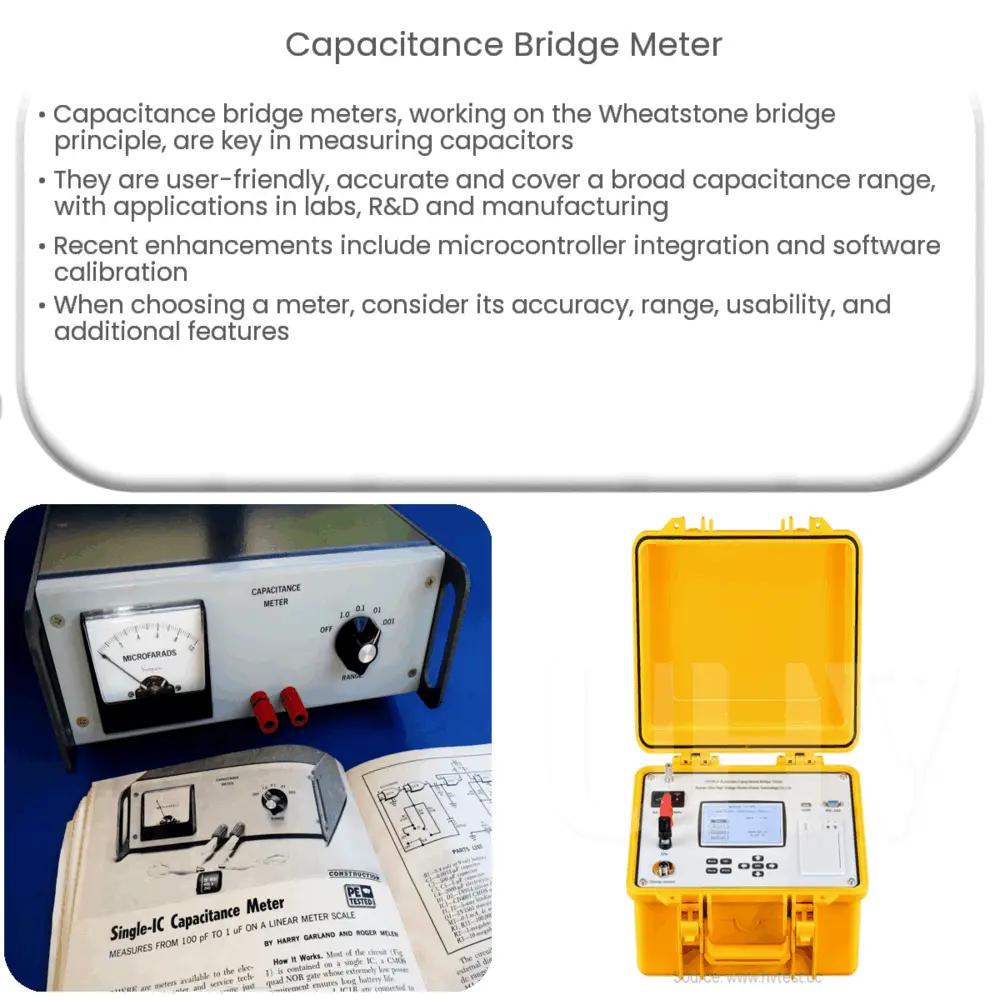Explore the functions, applications, and benefits of a capacitance bridge meter in this comprehensive guide. Understand modern advancements and selection criteria.

Introduction to Capacitance Bridge Meter
A capacitance bridge meter is a critical electronic instrument used to measure the capacitance of capacitors. This advanced instrument works on the principle of a Wheatstone bridge, a four-armed bridge that is balanced when the product of the resistances of two arms equals the product of the other two.
Working Principle of Capacitance Bridge Meter
The operational technique of a capacitance bridge meter is fascinating. In its basic form, a capacitance bridge includes four components. These are two known resistances, one known capacitance, and one variable capacitor. The four elements are connected in a bridge configuration, and a balancing condition is achieved when the product of the resistances equals the product of the capacitances. This is symbolically represented as R1/R2 = C2/C1, where R represents resistance and C denotes capacitance.
Applications of Capacitance Bridge Meter
The capacitance bridge meter is highly valuable in numerous applications. It is often used in electronic laboratories, research and development departments, and manufacturing industries. The main applications include:
- Measurement of unknown capacitance.
- Verification of capacitor specifications.
- Quality assurance in manufacturing processes.
Advantages of Capacitance Bridge Meter
Capacitance bridge meters offer various advantages, making them indispensable in many fields. Some of the key benefits include:
- High Accuracy: With a precise balancing method, capacitance bridge meters provide highly accurate measurements.
- Wide Range: They are capable of measuring a broad range of capacitance, from very small to very large values.
- Usability: The bridge meter is straightforward to use, and with proper calibration, it can provide reliable results.
Components of Capacitance Bridge Meter
The main components of a capacitance bridge meter include:
- Source of Power: This is usually an AC source.
- Galvanometer: This component detects the presence of current in the bridge.
- Known Capacitor and Resistors: These are the known components used for comparison.
- Unknown Capacitor: The component whose capacitance is to be measured.
Understanding the working, applications, advantages, and components of the capacitance bridge meter provides a comprehensive overview of its relevance in today’s world.
Using a Capacitance Bridge Meter
To use a capacitance bridge meter, the unknown capacitance is placed in one of the bridge arms. The other arms contain known resistances and a known capacitance. The bridge is then connected to an AC power source, and the galvanometer is connected across the bridge. The variable capacitor is adjusted until the galvanometer shows zero deflection, indicating that the bridge is balanced. At this point, the unknown capacitance can be calculated using the formula C1/C2 = R1/R2.
Modern Developments in Capacitance Bridge Meters
Modern capacitance bridge meters have been enhanced with digital technologies, increasing their precision and usability. Some of these advancements include:
- Microcontroller Integration: Modern meters are often integrated with microcontrollers to automate the balancing process and directly read the unknown capacitance value.
- Software Calibration: Software calibration techniques are used to enhance the accuracy of the measurements.
- Data Logging and Connectivity: Advanced meters can log data and connect to computers for further analysis.
Considerations when Choosing a Capacitance Bridge Meter
When selecting a capacitance bridge meter, several factors should be considered:
- Accuracy: The precision of the meter is crucial, especially for applications that require high accuracy.
- Range: The meter should be able to measure the range of capacitances required for your specific needs.
- Usability: The meter should be user-friendly, with an easy-to-read display and intuitive controls.
- Features: Extra features like data logging and connectivity might be beneficial depending on the application.
Conclusion
In conclusion, the capacitance bridge meter is an essential tool in electronics and manufacturing industries, allowing for the accurate measurement and verification of capacitors. With modern advancements in technology, these instruments have become even more precise and user-friendly. Understanding the fundamentals of how a capacitance bridge meter works, its applications, and the considerations to take into account when choosing a meter, can be highly beneficial for anyone involved in electronics or related fields.

